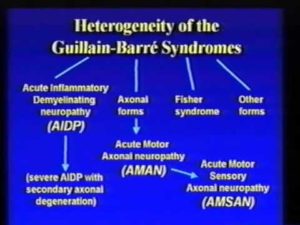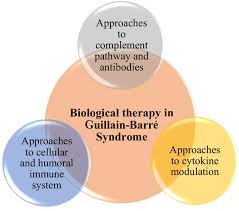Complications
Guillain-Barre syndrome affects your nerves. Because nerves control your movements and body functions, people with Guillain-Barre may experience:
- Breathing difficulties. The weakness or paralysis can spread to the muscles that control your breathing, a potentially fatal complication. Up to 30 percent of people with Guillain-Barre syndrome need temporary help from a machine to breathe when they’re hospitalized for treatment.
- Residual numbness or other sensations. Most people with Guillain-Barre syndrome recover completely or have only minor, residual weakness, numbness or tingling.
- Heart and blood pressure problems. Blood pressure fluctuations and irregular heart rhythms (cardiac arrhythmias) are common side effects of Guillain-Barre syndrome.
- Pain. Up to half of people with Guillain-Barre syndrome experience severe nerve pain, which may be eased with medication.
- Bowel and bladder function problems. Sluggish bowel function and urine retention may result from Guillain-Barre syndrome.
- Blood clots. People who are immobile due to Guillain-Barre syndrome are at risk of developing blood clots. Until you’re able to walk independently, taking blood thinners and wearing support stockings may be recommended.
- Pressure sores. Being immobile also puts you at risk of developing bedsores (pressure sores). Frequent repositioning may help avoid this problem.
- Relapse. Around 3 percent of people with Guillain-Barre syndrome experience a relapse.
Severe, early symptoms of Guillain-Barre syndrome significantly increase the risk of serious long-term complications. Rarely, death may occur from complications such as respiratory distress syndrome and heart attack.
Types of Guillean-Barre Syndrome:
Once thought to be a single disorder, Guillain-Barre syndrome is now known to occur in several forms. The main types are:
- Acute inflammatory demyelinating polyradiculoneuropathy (AIDP), the most common form in the U.S. The most common sign of AIDP is muscle weakness that starts in the lower part of your body and spreads upward.
- Miller Fisher syndrome (MFS), in which paralysis starts in the eyes. MFS is also associated with unsteady gait. MFS occurs in about 5 percent of people with Guillain-Barre syndrome in the U.S. but is more common in Asia.
- Acute motor axonal neuropathy (AMAN) and acute motor-sensory axonal neuropathy (AMSAN) are less common in the U.S. But AMAN and AMSAN are more frequent in China, Japan and Mexico.
When to see a doctor
Call your doctor if you have mild tingling in your toes or fingers that doesn’t seem to be spreading or getting worse. Seek emergency medical help if you have any of these severe signs or symptoms:
- Tingling that started in your feet or toes and is now moving up your body
- Tingling or weakness that’s spreading rapidly
- Difficulty catching your breath or shortness of breath when lying flat
- Choking on saliva
Guillain-Barre syndrome is a serious condition that requires immediate hospitalization because it can worsen rapidly. The sooner appropriate treatment is started, the better the chance of a good outcome.
How Guillean-Barre is Diagnosed:
Guillain-Barre syndrome can be difficult to diagnose in its earliest stages. Its signs and symptoms are similar to those of other neurological disorders and may vary from person to person.
Your doctor is likely to start with a medical history and thorough physical examination.
Your doctor may then recommend:
- Spinal tap (lumbar puncture). A small amount of fluid is withdrawn from the spinal canal in your lower back. The fluid is tested for a type of change that commonly occurs in people who have Guillain-Barre syndrome.
- Electromyography. Thin-needle electrodes are inserted into the muscles your doctor wants to study. The electrodes measure nerve activity in the muscles.
- Nerve conduction studies. Electrodes are taped to the skin above your nerves. A small shock is passed through the nerve to measure the speed of nerve signals.
Treatment
There’s no cure for Guillain-Barre syndrome. But two types of treatments can speed recovery and reduce the severity of the illness:
- Plasma exchange (plasmapheresis). The liquid portion of part of your blood (plasma) is removed and separated from your blood cells. The blood cells are then put back into your body, which manufactures more plasma to make up for what was removed. Plasmapheresis may work by ridding plasma of certain antibodies that contribute to the immune system’s attack on the peripheral nerves.
- Immunoglobulin therapy. Immunoglobulin containing healthy antibodies from blood donors is given through a vein (intravenously). High doses of immunoglobulin can block the damaging antibodies that may contribute to Guillain-Barre syndrome.
These treatments are equally effective. Mixing them or administering one after the other is no more effective than using either method alone.
You also are likely to be given medication to:
- Relieve pain, which can be severe
- Prevent blood clots, which can develop while you’re immobile
People with Guillain-Barre syndrome need physical help and therapy before and during recovery.

